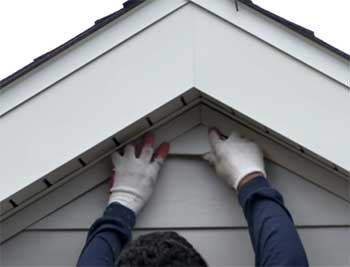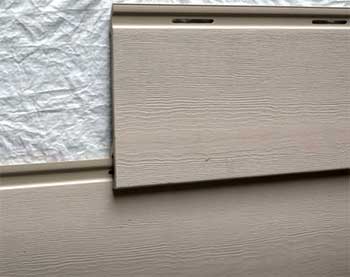As a homeowner, selecting durable and long-lasting exterior siding is one of the most important decisions you’ll make. Siding protects your home from weather and wear and tear over time. It also impacts the curb appeal and look of your home.
Everlast siding aims to provide a reliable composite siding option made from recycled materials. However, some homeowners report experiencing problems with Everlast siding after installation.
In this comprehensive guide, we’ll explore common Everlast siding problems reported by homeowners. We’ll provide details on each issue, along with tips to prevent or address them. Read on to learn what problems to look out for if you’re considering Everlast siding.
Problems With Everlast Siding

Here is a list of those issues:
- Fading and Discoloration
- Flaking and Peeling Paint
- Warping and Distortion
- Hollow Sounds When Tapped
- Issues With Corner Pieces
- Mold and Mildew Growth
- Issues at Seams Between Pieces
- Difficulties With Attachment and Nailing
Let’s explain those problems in detail.
- Fading and Discoloration
One of the top complaints from Everlast siding owners is early fading and discoloration. Within the first 2-3 years, some homeowners report the siding noticeably fading, losing its original color vibrancy. This is likely attributed to the acrylic latex paint used on Everlast siding products.
Compared to other paints and finishes, acrylic latex tends to fade faster when exposed to sun, heat, and other outdoor elements.
Fading can occur unevenly as well, leaving siding looking patchy or blotchy in areas. This creates an unsightly, mismatched exterior. Unfortunately, there is no great fix for faded siding other than repainting or replacing it entirely.
When considering Everlast siding, keep in mind you may need to repaint within 5 years or less to restore the original color. Choosing darker color shades may help disguise fading issues longer. Proper maintenance can also help slow color loss.
- Flaking and Peeling Paint

In addition to rapid fading, the acrylic latex paint on Everlast siding may also begin flaking or peeling within the first few years.
Many homeowners complain of paint chipping, cracking, and peeling off in sheets.
This leaves unsightly patches on the siding and requires extensive scraping, sanding, and repainting to fix.
Contributing factors for paint failure include inadequate surface prep before painting, improper painting techniques, moisture issues, sun exposure, and normal wear. To help prevent flaking and peeling, ensure siding is installed properly by experienced professionals.
Use high-quality acrylic latex paint and prime before the topcoat. Inspect siding yearly and repaint when needed to stop peeling before it worsens.
- Warping and Distortion
The composite material used for Everlast siding can also lead to warping and distortion issues over time. As temperature and humidity levels change, the siding expands and contracts. This results in waviness, buckling, and protruding sections.
Areas around windows and doors are especially prone to warping since they receive more direct sun exposure.
Poor installation is another factor that causes siding to warp. If underlying materials or surfaces are uneven, siding can buckle against them.
Using defective or damaged pieces also leads to distortion as the siding ages. Preventing warping issues requires installing siding properly on an even surface. Leaving proper spacing around openings and using undamaged, quality materials also reduces warping.
- Hollow Sounds When Tapped
Tap testing along the length of Everlast siding reveals another common problem – hollow, popping sounds. This indicates delamination within the siding composite layers.
Moisture seeping between the layers causes the material to separate and bubble. Then as it expands and contracts during temperature changes, it makes a noticeable popping noise.
Hollow areas typically spread and worsen over time. Eventually, bubbled sections may become distorted or damaged beyond repair. Preventing moisture issues during installation is key.
Proper sealing and adequate vapor barriers keep water from seeping behind siding. Routine inspections and repairs help catch minor hollow spots before they expand. But delamination often requires replacing sections.
- Issues With Corner Pieces

Many homeowners report issues with Everlast siding corner pieces not fitting flush.
This leaves noticeable gaps where siding meets at corners.
Gaps allow moisture intrusion and insect access behind siding.
The gaps also look unsightly and detract from the home’s appearance.
Contributing factors include slight size variations between siding pieces and corner modules. Installation errors like nailing corner pieces incorrectly can also prevent proper fitting. Taking time to ensure corner pieces match up and trimming if needed helps prevent gaps.
Using high-quality materials and precise installation techniques improves the fit. Caulking or flashing may fix small gaps, but larger gaps require replacing damaged pieces.
Also Read: Common CraneBoard Siding Issues.
- Mold and Mildew Growth
Everlast siding is also prone to developing dark mold or mildew growth in certain outdoor environments. Humid climates, shaded areas, and poor air circulation contribute to fungal growth on siding. Mold and mildew appear as black or gray spots across the siding surface.
Besides looking unsightly, mold weakens siding and paint over time. Preventing moisture buildup is key to inhibiting mildew growth. Proper overhangs above siding, ventilation, and moisture barriers keep siding dry.
Routine power washing also removes mold before it takes hold. Catching and treating fungal growth early helps prevent long-term damage.
- Issues at Seams Between Pieces
Gaps, popping, and separation at the seams where siding pieces join are another common complaint. As temperature and humidity cause the siding to expand and contract, seams may pull apart. Gaps then allow moisture intrusion and pest entry behind siding.
Careful installation aligning and nailing pieces precisely reduces gaps. Using high-quality materials also minimizes size variations that lead to gaps. Caulking, flashing, or trim pieces can seal small gaps at seams.
But more significant separation requires replacing damaged sections of siding. Routine inspections and maintenance checks for seam issues early.
- Difficulties With Attachment and Nailing
Compared to other siding materials, some installers report Everlast siding can be more difficult to work with. The thick composite material is stiff and challenging to maneuver into place.
Cutting neat openings for fixtures also requires special saws. Nailing the siding flush is tricky due to its density. Misdriven nails cause ripples in the siding surface.
Hiring experienced installers familiar with Everlast products can prevent attachment issues. Using the manufacturer’s recommended nails, spacing, and techniques also improves installation.
Taking time to position and nail the siding carefully reduces mistakes. Insufficient nailing leads to loose or warped pieces over time. Proper nailing along with adhesive creates a secure, flat attachment.
Also Read: Common Problems With NuCedar Siding.
Frequently Asked Questions (FAQ)
Everlast can be a decent composite siding option thanks to its recycled materials and low-maintenance finish. However, it’s prone to problems like fading, peeling, and distortion over time. It also carries a high price tag compared to other sidings.
Common issues with composite siding like Everlast include fast fading, paint peeling, warping, gaps at seams and corners, hollow spots, mold growth, and difficulty with installation and attachment. Temperature changes cause expansion and contraction that leads to many issues.
With proper installation and maintenance, Everlast siding should last around 15-20 years. But many homeowners report issues with fading, peeling, and warping occurring before the 10 year mark. Harsh climates or improper installation accelerate deterioration.
Everlast siding comes pre-painted from the manufacturer. But touch up painting is often needed within the first 5 years as the coating fades and peels. Plan to repaint every 8-10 years to maintain the original color. Darker, bolder colors hold up better than light shades.
Wrapping Up
Everlast aims to offer a low-maintenance, environmentally-friendly siding made from recycled materials. But several inherent flaws lead to problems over time, requiring extensive repairs or replacement.
Issues like fading, peeling, distortion, and gaps leave homeowners dissatisfied with the product’s performance and costly upkeep.
If you decide to install Everlast siding, take steps to reduce potential problems. Hire experienced installers, follow all manufacturer guidelines, use high quality materials and paints, and properly maintain the siding.
However, other composite or natural wood siding options provide better longevity and performance for your investment. Carefully weigh the pros and cons of Everlast siding before committing to this exterior cladding for your home.

I am building a new home on the lake in upstate New York. What would you recommend for siding.
What are the other composite siding options? Wood is a constant maintenance no matter what you install in my opinion. We would prefer wood but I cannot find anything that will not turn grey/silver.